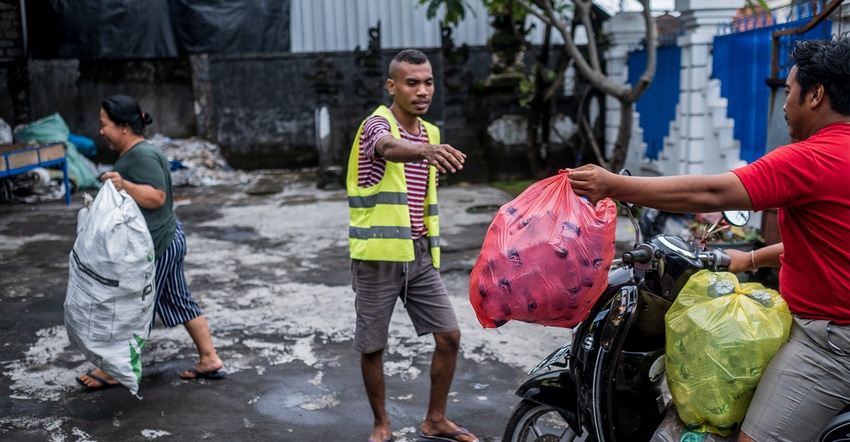By driving the demand for recycled plastic, consumers have a role to play in turning this situation around, but real change requires government intervention.
March 10, 2023

Raffi Schieir, Director, Bantam Materials
Every year, more than 400 million tons of plastic is produced worldwide - more than a third of which is packaging. As it stands, global recycling systems can’t cope with this volume, which means only 9 percent of plastic is being recycled worldwide.
In the UK, for example, well over half of the household plastic packaging that the government claims is being recycled is actually sent abroad. Most of it ends up in countries with very low recycling rates, sometimes leading to plastic waste being dumped or illegally burned.
How do we take this 9% and turn it into 100 percent? The answer lies with demand. For a circular economy to work we need to think less about what we’re throwing away and more about what we’re building in. In other words, we need to stop thinking about recycling in terms of sorting plastic in our household bins, instead thinking about how we ensure this plastic is repurposed and given a new life.
The UK government is taking some steps to improve this situation, like announcing plans for a deposit return scheme, so that consumers can return plastic bottles via vending machines in supermarkets. But such initiatives are nowhere near enough to address the sheer scale of the world’s plastic crisis.
95 percent of plastic packaging loses its material value, equivalent to $80-120 billion annually, after just one use. Through a circular economy, we could retain the value of this plastic so it doesn’t end up as litter or pollution.
However, in our current economic climate, many businesses are showing no signs of reducing their dependence on new plastic. So, how can we incentivize businesses to adopt sustainable practices to protect our environment from plastic pollution?
Some might argue that the key lies with consumers, saying it’s down to individuals to change their behavior, recycle better and stop buying so much single-use plastic. Others believe that responsibility lies with governments to push forward legislative and structural change.
Of course, individual actions matter. As consumers, we can all make better choices, for example choosing products in recycled packaging to ensure recycling has actually happened. This increased demand for more environmentally sustainable packaging would stimulate supply and drive the recycled plastic market forward. However, the enormity of the crisis in which we’re mired and the short timeframes in which we must act mean that to close the loop, we will need ambitious government intervention to drive the transformation. Consumers impact demand. But governments have it in their powers to stimulate demand on an enormous scale too.
We require urgent systemic change and that requires innovative policies. In practice, this means proper investment in better recycling infrastructure and incentivizing businesses to use recycled plastic, for example by increasing Plastic Packaging Tax penalties to businesses who aren’t using recycled content across all their lines. If governments added a minimum requirement of 50% recycled plastic, which plans to increase this figure over time, we’d likely triple the amount we are recycling. The government should also move forward with Extended Producer Responsibility (EPR) schemes – requiring companies to take responsibility for all the plastic they produce right through to the end of its life. That’s how to build a truly circular economy.
The Prevented Ocean Plastic Programme is as an example of the kind of large-scale, quality plastic recycling program that nurtures a circular economy so that plastic retains its value and doesn’t end up in our environment as pollution or litter. We make high-quality recycled plastic from discarded bottles found on coastlines in the regions at risk of ocean plastic pollution. At the same time, we provide a reliable and fair income for people living in developing countries, generating opportunities for local people. To date, we have saved over a billion bottles from entering the ocean and expect to save another billion in the next 18 months. We can trace the materials we use every step of the way, from collection centres in at-risk coastlines to finished products on supermarket shelves.
Beyond packaging, we also want to see virgin plastic replaced with recycled alternatives within products themselves. A recent example of this is our work with responsible outdoor clothing company Patagonia, which us using Prevented Ocean Plastic in their range of top-performing men’s and women’s running and climbing shorts.
But not all businesses are currently as invested in responsible supply chains as Patagonia. Without legislation forcing businesses to act, they won’t put investment behind such comprehensive solutions. This is especially true during the cost-of-living crisis, which many companies are using as an excuse to put on the backburner their ethical and environmental standards.
With the world producing twice as much plastic as it was two decades ago, global recycling systems are failing. Most plastic waste is ending up in landfill, the oceans or incinerators – which release toxic gases and harmful particles into the atmosphere. By driving the demand for recycled plastic, consumers have a role to play in turning this situation around, but real change requires government intervention. With plastic now polluting our planet from the top of Mount Everest to the deepest depths of the ocean, it’s more than time that policymakers around the world stepped up and tackled the unprecedented crisis we face.
Raffi Schieir is the director of Bantam Materials.
You May Also Like


